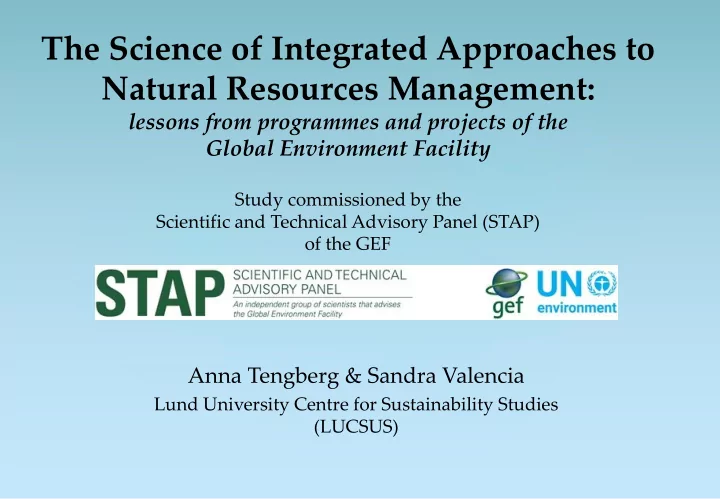

The Science of Integrated Approaches to Natural Resources Management: lessons from programmes and projects of the Global Environment Facility Study commissioned by the Scientific and Technical Advisory Panel (STAP) of the GEF Anna Tengberg & Sandra Valencia Lund University Centre for Sustainability Studies (LUCSUS)
A Holistic Methodology Domains of integration System analysis: boundary, main Literature review processes, actors and feedbacks Systems thinking Additional criteria for Across Focal Areas Integrated case studies approaches to NRM Across GEF agencies Information sources Spatial Rapid screening of a Assessment tools for random sample of Environmental and Development socio-ecological impacts Multi-Focal Area (MFA) Concerns projects Extent and Across Policy Domains sustainability of 10 Case studies – Into Productive Sectors and integration Integrated Approach Investments Pilots (IAP) and MFA Innovation in design projects Vertical and/or implementation Multiple Stakeholders Interviews with key informants Equity Concerns Adaptive Learning into Governance
Literature review: Main characteristics of INRM Born & Sonzogni (1995) Comprehensive: It considers the whole system rather than 1. certain subcomponents; Interconnective: Addresses linkages and feedbacks; 2. Strategic: Recognizes the need to pragmatically limit the 3. number of variables and feedbacks to be addressed while maintaining comprehensiveness; and Interactive/Coordinative: Favours joint decision-making 4. among stakeholders and exchange of resources and information among interested parties, as well as conflict resolution elements.
Results from rapid screening of ProDocs System boundary : usually vaguely defined Is the system boundary Analysis of System Missing: what is considered clearly defined? external good nothing nothing 25% yes yes 29% little Integration across policy 40% domains: limited to no some no some little 60% 25% environmental and agricultural 21% good related sectors Integration across different domains Spatial integration Adap ve� Learning� into� Governance� Equity: gender considered (but limited), few projects Equity� Concerns� target the most vulnerable or Mul ple� Stakeholders� poorest populations Ver cal� Participation of Into� Produc ve� Sectors� and� Investments� yes� stakeholders : in consultations limited� Across� Policy� Domains� but limited co-production or no� role in steering committees Environmental� and� Development� Concerns� Spa al� Learning and Adaptive Mgt: limited during project Across� GEF� agencies� implementation 0%� 10%� 20%� 30%� 40%� 50%� 60%� 70%� 80%� 90%� 100%�
In-depth case studies
Generic Theory of Change for INRM Areas of GEF contribution Outcomes Impact Transformational Processes Improved INRM technologies Spatial planning and approaches generate GEBs (landscape/seascape) Broader adoption of Improved INRM approaches Innovation systems for INRM integrated produce gender-balanced socio- Improved approaches to economic benefits environmental natural resources Monitoring and Assessment of status and stress management Institutional innovations support GEBs and co-benefits of INRM reduction in scaling up and out, e.g.: globally significant Behavioural and - co-management Sectoral integration & landscapes and institutional change: - collective action mainstreaming of INRM seascapes - policy level - participatory governance - users of natural Learning & Adaptive resources Financial mechanisms and knowledge management incentives for INRM in place, examples: Communication & - PES dissemination - value chains Single-loop : Double-loop : Triple-loop : - Basic correction of errors and - Underlying values and policies are New governance mechanisms improvement of standard practices examined and protocols are designed - No change in underlying assumptions - Old habits are unlearned based on based on iterative learning Learning cycle or established routines critical reflection of experiences cycles
INRM Theory of change and the transition from niche adoption to regime shift and landscape development (figure draws inspiration from Geels 2002) Developments Landscape Strategic partnerships Multistakeholder knowledge platforms Behavioural change and scaling up of INRM Technical Regimes Socio- Policy integration Markets, user practices Financial mechanisms and Incentives (e.g. value chains, PES) in place Technological Technology Innovation systems for INRM - Niches co-production, institutional innovations, social capital INRM technologies and approaches Time
Conclusions Understanding the system – Focusing on drivers of environmental change A theory of change for INRM helps in understanding impact pathways to achieve short, medium and long-term environmental and socio-economic benefits and impact at scale. Transformative change – starts at the local level where niches of innovation, experimentation and learning occur that are scaled up through regime shifts that lead to wider adoption at the landscape level. Enable learning, innovation and adaptive management – need to aim for higher levels of learning, such as single, double and triple loop learning Strengthen communication – messages tailored to different target groups to raise public awareness. Incorporate conflict-resolution mechanisms – Avoiding conflicts in complex systems should build on existing institutions and collective action initiatives at the local level and the setting of clear rules. To foster functioning partnerships - setting clear rules for engagement and interaction is as relevant at the international and regional levels as it is at the local level.
In summary: Integration is an important concept that helps addressing complex social- environmental problems and it could also contribute to more effective implementation of the SDGs.
Recommend
More recommend